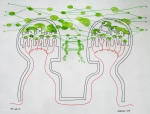The art of living as a psycholgical millionaire: To use your energy in a way that gives you a result you need.
A person with the possibility of becoming a psychological millionaire does just this. For this to happen, certain principles must be satisfied. Efficient mental energy has four caracteristic features. Its:
– Adaptive
– Goal-oriented
– Successful
and
– Devoid of waste
Examples of non-efficient living:
Certain diagnostic groups can have enough mental energy, but low mental efficiency. This can for example be clients with AD/HD or Borderline personality disorder. They might do a lot of things, like walking around in a room restlessly or having an emotional outburst. Their problem is using the energy in a good way: They can`t regulate it in a way that makes it able to live a good life. Some groups have too low energy to be efficient, like with depressed or fatigued clients.
When working with dissociation, parts have different levels of mental energy and efficiency. EP`s can actually be the most energetic parts in the system, but have very low efficiency, since they repeat behoviors in a dysfunctional way. It is possible to have a dissociative disorder like DID and borderline PF at the same time. In this case most parts will have borderline features, that is: High levels of mental energy but low efficiency.
Energy and efficiency in trauma
“Looking in a cupboard that is empty, will not work no matter how good the torch is”. Nijenhuis, 2013
Trauma can also be understood by using the concept of energy and efficiency. Trauma can be either too much or too little energy or efficiency. For example, an EP can feel stuck, with high levels of energy, but low levels of efficiency. The EP can`t “get out of it”. There is no symbolization of the event, since it “feels like” the trauma is still going on. The part or the EP is “stuck” in what was. To connect the then with the now, it`s necessary to reach the reach the higher level of language, and that is easier when an empathic therapist helps the EP. Empathy is necessary to tune in to the EP`s experience. If the EP is afraid, the voice of the therapist must be soothing and calm. The therapist must tune in so that the EP is seen and validated. When the therapist tries to understand the EP, the ANP of the patient might learn that it`s possible to collaborate and help EP`s.
Example of working with an EP with enough mental energy
Imagine a claustrophobic EP (picture 1). The EP has trouble breathing because her throat feels constricted. The therapist might observe this, and tune in to this with a low, empathic voice “It looks like you have trouble breathing ?” The therapist observes that the EP tries to nod. The therapist continues: “I see you tried to nod, but it looks like its hard to move?”. The therapist explores the EP`s experience, thereby respecting and validating her.
The therapist can also ask the EP to try to broaden her field of consciousness, by asking if they can try to breathe slower or by asking of if the EP could look at something around her that is comforting. He can also try to tell the EP that she is safe, that boundaries will be respected, or say that everything will be okay. Moreover, the therapits can make it clear that the EP decides what happens next, and that everything will be predictable and safe. The therapist watches the EP and helps her, where she is, there and then.
Working with a non-verbal EP
If the EP is young and can`t talk, one has to communicate non-verbally. For example, if the EP is in “freeze-mode”, the therapist can ask questions about the inner experiences of the EP: “Can you find a place in yourself where you have some ability to move?” If the EP moves the ANP`s finger just a tiny bit, the therapist might say: “Is it possible to move your finger a little bit more?” Gradually, the EP is exposed to new experiences that will be healing in time.
If the frozen EP is able to move, either by actually walking around in the room, the EP learns what it couldn`t when abuse happened. When the therapist is able to intone and be there for the EP`s, magic can happen. I`ve experiences this myself, and every time it feels so meaningful. To see a afraid little EP starting to feel stronger, feels like I`ve been able to lift a heavy weight together with them. Therapy is heavy work. The EP must shred the cloak of repression that weigh down on them, and that cost a lot of mental energy. This means that the client must have enough mental energy available.
If he is tired, starved, physicially unfit or doesn`t do anything inspiring that gives joy or energy, it might be best to wait until more energy is available. Trauma-therapy is hard work, and cost both physical and mental energy. Going into trauma-material before the client has filled up her batteries, is not recommended.



 More than a century ago, scientists discovered something usual about how people with
More than a century ago, scientists discovered something usual about how people with 











